One of the things I love about communist Chinese propaganda is how it's possible to read specific pieces of history into many, if not most of the posters. You'll regularly find some element, hidden or overt, which connects the poster with a particular person's fate, a movement, an executive decision or the like. This becomes particularly clear during the Cultural Revolution, when you can see various individuals and factions waging propaganda warfare on each other through posters.
For a history student like myself, this is a treat, but even if you're not the least bit interested in history, you should have no trouble finding lots of interesting material in this post.
My earlier posts on Soviet, US and German propaganda have all been done as single posts. In this case though, I found so much great quality material that I decided to split it up instead. This is part 1, dealing with the period from World War II up until the end of the Cultural revolution. Check back soon for part 2!
World war, revolution and another war
In the century leading up to the proclamation of the Chinese People's Republic in 1949, China had seen a seemingly endless string of foreign invasions, civil wars and rebellions, with plenty of warlordism to fill the gaps. There are no exact figures for just how many deaths all this turmoil caused, I've seen estimates ranging from 150 to 300 millions.
Sadly, 1949 would not be the end of the troubles for China. In this part, we take a look at 42 propaganda posters from 1937 to 1969, including a little commentary from me, mainly to put it all into a historic context.
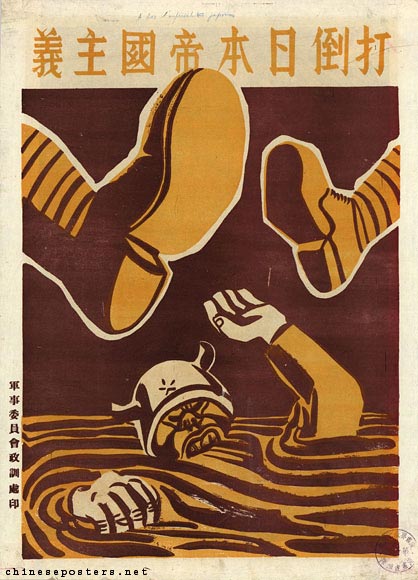
1937 – Defeat Japanese imperialism
In 1931, Japan invaded the Chinese province of Manchuria and turned it into the puppet state Manchukuo. It could be seen as the first action of the second world war, as low scale warfare between Japan and China would continue until 1937, when Japan invaded northern China, a bloody war that would carry on until 1945.
The nationalist Kuomintang forces of Chiang Kai-Shek temporarily joined forces with the communist rebels and the fighting eventually reached a stalemate, with the Japanese controlling the coastal lands while the Chinese defended the interior.
This poster, printed by the Kuomintang, China's official governing party at the time, has more in common with contemporary posters from Europe than with what would eventually follow in the People's Republic. The graphic simplicity of this poster is not completely lacking in post-revolution posters, but in general, later posters tend towards significantly greater level of intricacy and a more pictorial style.
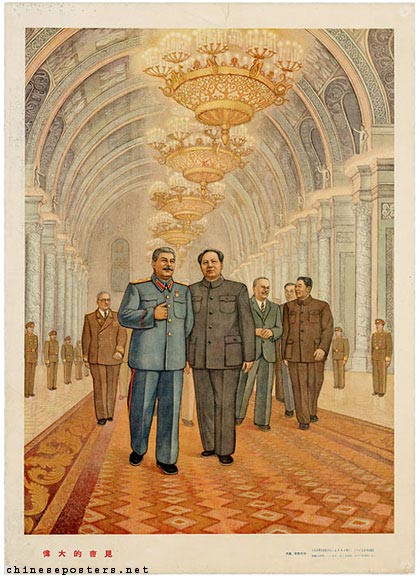
1949 – Great Meeting
On October 1st, 1949, Mao Zedong proclaimed the Chinese People's Republic, and on the 10th of December the same year, the last Kuomintang stronghold in mainland China fell, with Chiang Kai-Shek escaping to Taiwan to set up his Republic of China. A few days before, Mao had set off by train to Moscow, to meet with the leader of the world's other great communist country, Stalin.
Contrary to what this poster indicates, the Soviet reception of Mao was lukewarm at best. Stalin and his people were not willing to recognize the importance of China turning communist, and made it clear by their poor treatment of the Chinese leader. An aide of Krushchev's referred to him as "that Chinaman". While the Chinese delegation was able to wring some promises of material aid from the Soviet Union, it was "like taking meat from the mouth of a tiger", as Mao would later comment.
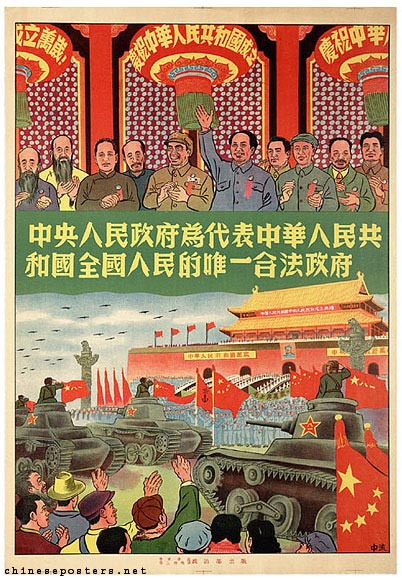
Ca. 1950 – The Central people's government constitutes the only legitimate government of all
As the message indicates, the Chinese Communist Party felt an urgent need to demonstrate their legitimacy in power, as opposed to the exiled Kuomintang on Taiwan. Most of all, this poster reminds me of a Tintin cartoon - I'm half expecting to see Tintin popping up behind Mao with a silly grin on his face, or Terry attacking the tanks.
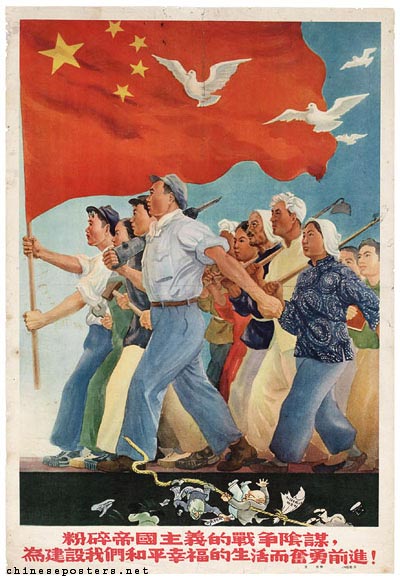
1950 – Smash the imperialist war conspiracy, forge ahead courageously to build our peaceful and happy life!
The (territorial part of the) communist revolution was barely finished when the People's Republic was reluctantly dragged into another war, this time in Korea. North-Korea had invaded the south and made great advances, only to collapse once the US and the United Nations got involved on the side of the South.
US General MacArthur, happy with the initial success, decided to press on into the north and drive home a complete victory. This compelled the People's Republic to enter the war, and thus followed three years of bloody stalemate resulting in an estimated 4 million deaths and no significant territorial changes.
With white doves flying above, the poster suggests that the People's Republic did not want this war, but were forced into it by US and British imperialists, as illustrated by the little caricatures being trampled underfoot.

Ca. 1950 – The Chinese people absolutely cannot condone the encroachment of other countries, and cannot listen to whatever Imperialist who thinks it can wantonly encroach on its own neighbours without them acting
In a more gruesome tone, General Douglas MacArthur is here seen murdering Korean women and children while US bombers level Korean industry. While MacArthur was a great military leader in some ways, he repeatedly asked for permission to attack China itself, and had a long record of recklessness and often disobeyed orders.
These traits proved fateful in Korea, where MacArthur's decision to conquer (or alternately, liberate) the whole of Korea, all the way to the Chinese border, forced the Chinese to intervene. Contrary to the message in this poster, Chinese involvement was not a given in Korea once the US got involved. After a century of turmoil in China, the leadership would probably have preferred to stay out of the fray.
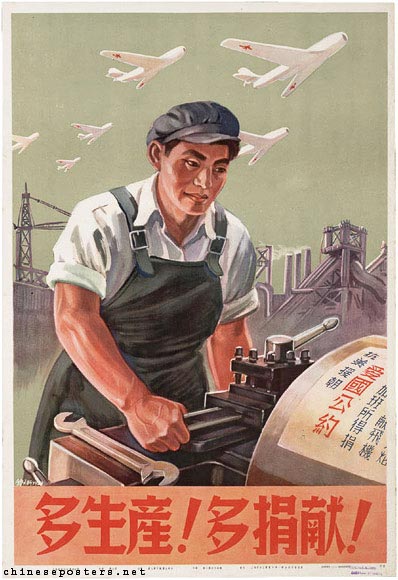
Ca. 1951 – Produce more! Contribute more!
Now we're talking! This is how I like my communist propaganda. Big, muscly men or women labouring away like superheros with sledgehammers or working with tireless resolve on some machine producing bolts for the latest tractor model.
The jet fighters zooming above may not be directly related to this guy's work, but they add another element of raw strength and technological advance to the poster.
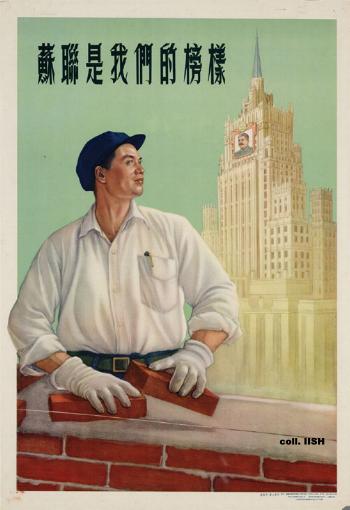
1951 – The Soviet Union is our example
While the Soviet Union and the People's Republic were not the best of friends, in the early cold war period, there were few other friends to be had for communist China. Up until the late 50s, there was considerable cooperation between the two.
This poster suggests learning construction techniques from the Soviet Union. Looming in the background with a portrait of Stalin is one of the Seven Sisters of Moscow. The sisters were great buildings erected during Stalin's last year, and are some of the masterpieces of Stalinist architecture. After Stalin's death, Krushchev would condemn Stalinist architecture as excessive.

1953 – Elect good people to do good things
Speaking of Stalin, the guy in white immediately made me think of him. With the poster printed in the year of Stalin's death, is this perhaps a suggestion of Stalin's reincarnation in China? Probably not.
Nevertheless, whenever I see leader characters dressed up in white, I can't help thinking about Stalin and Hermann Göring, who were both frequently pictured in bulky, silly looking white uniforms.
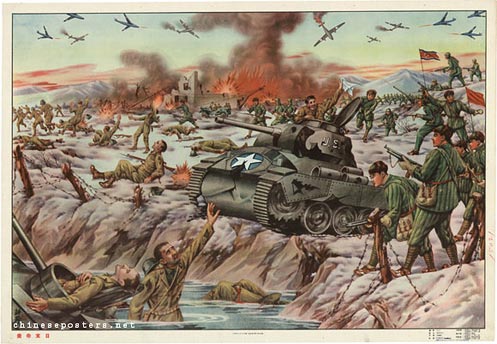
1954 – Judgement day for American imperialism
A rather one-sided portrayal of the outcome of the Korean war. Just as expected of course. The combined forces of North-Korea and the People's Republic are seen surging ahead, grinding the American imperialists into the mud.
In fact, estimates suggest that communist deaths outnumbered those of the UN forces by 3 to 1. As is always the case in modern warfare, the number of civilian deaths were the highest of all, estimated at around 2 million.
Reconstruction and the great leap backwards

1955 – New China's female parachuters

1955 – Resolutely liberate Taiwan, save the Taiwanese people from their misery!
Officially known as the Republic of China, present day Taiwan is the legacy of the Kuomintang withdrawal from the Chinese mainland. Ever since the end of World War II, the US has supported the Kuomintang and the ROC on Taiwan, and this has been an eternal sore spot in relations between the US, the ROC and the People's Republic.
Being under martial law for nearly four decades succeeding the communist victory, the ROC could hardly have been the model of freedom, though I suspect this particular poster to be a rather too vivid depiction of the situation.
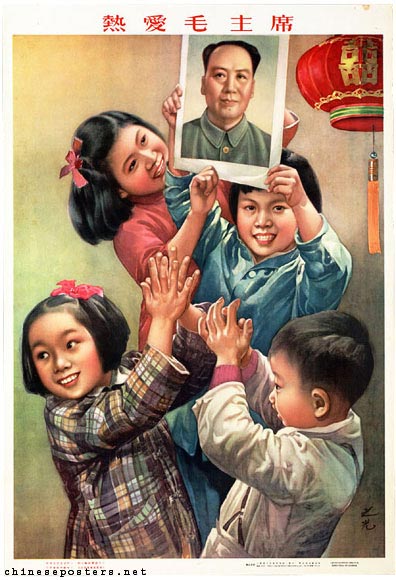
1955 – Warmly love chairman Mao
There is quite a wide variety of artistic styles seen in the propaganda posters of the People's Republic, making it somewhat hard to make generalizations about them.
However, this poster to me seems to capture some of the essence found in many of the posters. As mentioned when discussing the very first poster, complex designs are more favoured than the often highly stylized material seen in the Soviet Union, USA and Germany.
These posters tend to be more naturalistic in their portrayal of people, albeit with a significant "sweet icing" to give the people a more idealized look, and to convey a more positive, cheerful outlook, something which was probably needed in these years.
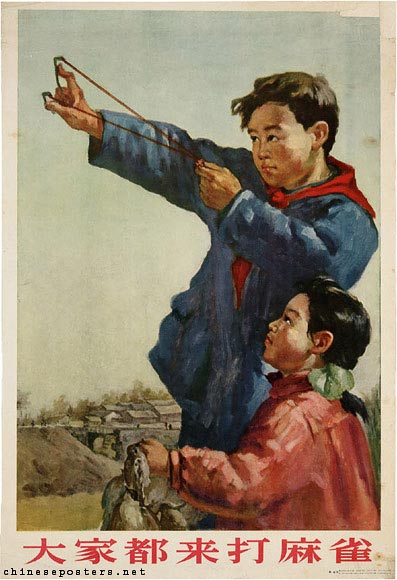
1956 – Everybody comes to beat sparrows
Another poster in a similar style, it depicts a scene which seems fairly innocent at first glance. But as I mentioned in the introduction, there's nearly always some particular historic event which can be connected to the different posters. In this case, it's what was officially called the "Four pests campaign", but became better known as the Great sparrow campaign.
In essence, Mao decided that the sparrows, and some other birds and animals, were vermin that ate grain seeds and thereby lessened agricultural output, and so, people were ordered to kill sparrows en masse. This they did, with great effect. In 1960, scientists discovered that sparrows in fact ate more harmful insects than grain, something which became painfully obvious when the locust population exploded and caused great damage to agriculture.

1956 – Helping mama study culture
Another piece of "socialist realism", less glossy than the two before. And while the visual style of the poster isn't glossy, nor the problem of illiteracy glossed over, it fulfills its role as propaganda by idealizing the young girl as a model of good behaviour, passing on what she's learnt at school to her illiterate mother.

1958 – Our motherland's air-space shall not be violated
A curious, spectacular and, to my knowledge, somewhat unusual character of the People's Liberation Army is that for much of its history, it basically controlled the whole production chain for all the products and commodities it required.
It owned its own farms, manufacturing plants and weapons production. To my knowledge, this system largely remains to this day, though from what I've been able to gather, changes have been made, and may continue to be made, to the structure.

1958 – Study the Soviet Union, to advance to the world level of science
I like this poster for its depiction of technology, represented by some weird supersonic jetplane, an icebreaker and some sort of spacecraft, as well as an absent-looking (or visionary) scientist. Waving his hands into nowhere, he reminds me more of a magician performing tricks than a scientist.
The year before, Mao had visited Moscow and scared the living hell out of his Soviet colleagues by asserting that he would be OK with sacrificing 300 million Chinese in a nuclear war that would lay the capitalist world in ruin. We will never know whether Stalin would have agreed, luckily the old cynic died in the early stages of the Soviet nuclear program.
Around the time of this poster being printed, relations between the Soviet Union and the People's Republic started souring, ending with a clean break in 1960, followed by intermittent, low scale border warfare between the two.
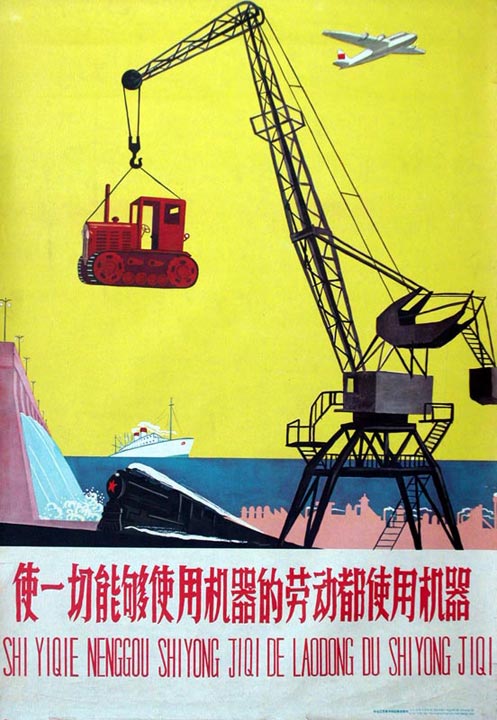
1958 – Use machinery to replace manual work whenever possible
1958 was the starting year of the People's Republic's second five year plan, better known as the Great Leap Forward. It would be the first of two massive disasters instigated by Mao, and meant that the calm years since the Korean War would only be an interlude in the long turmoil that is China's modern history.

1959 – Smelt a lot of good steel and accelerate socialist construction
The Great Leap Forward had two central goals, increasing food production through massive collectivization and increased use of machinery in agriculture, as seen above, and self-sufficiency in the production of machines. To achieve the latter, Mao advocated widespread use of backyard furnaces, whereby people would construct iron smelters in their backyard to churn out what in Mao's mind would be quality steel.
As we've seen in the case of the sparrows, Mao often didn't have a clue about the feasibility of the projects he launched, and would not listen to advice. Likewise with the backyard furnaces. Enormous amounts of steel were indeed produced, but of so low quality it was useless.
Famously, even pots and pans were sometimes melted by the zealous backyard metallurgist. Learning of the project's failure in 1959, Mao decided not to stop it, as this could risk dampening revolutionary fervor in the people.

1959 – The vegetables are green, the cucumbers plumb, the yield is abundant
Propaganda should preferably polish the truth by making the bad guys look really bad, the good guys really good and in general, make a situation look brighter than it is. In this case however, it was a lie, flat out. As early as 1958, famine had set in in parts of China, and with poorer weather conditions for agriculture in 59 and 60, the situation got even worse.
Along with extensive collectivization, which had already proven problematic at best in the Soviet Union, Mao and his supporters introduced many novel – and catastrophically bad – farming techniques, which were supposed to give greater yields, but did exactly the opposite. The locust swarms which appeared thanks to the near-eradication of sparrows didn't help either.
The net effect of the Great Leap Forward was a catastrophic death-toll in the years 1958-61. The official number of deaths is 17 millions, most independent estimates range from 30-40 million, while the highest I've seen being 70 million.
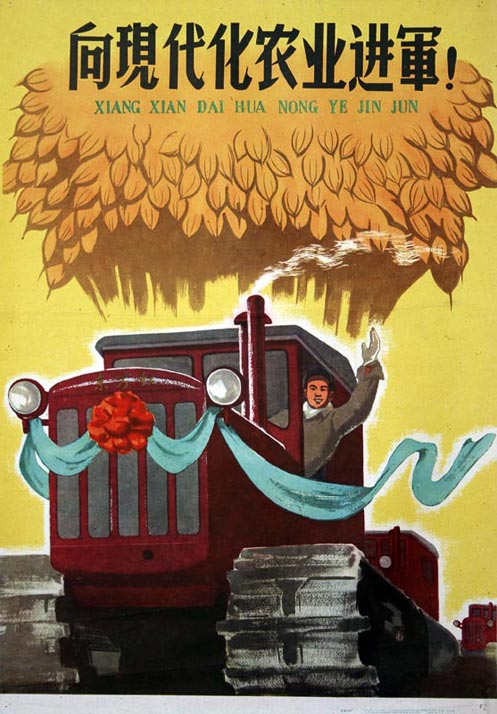
1960 – Agriculture is marching towards modernization
I don't know whether it's a coincident or intended, but shape of the grain above the tractor is remarkably similar to a nuclear mushroom. It's perhaps to suggest that tractors are as revolutionizing to agriculture as nukes are to warfare?
I don't have any particular obsession with machines or tractors in general, but for some reason, I've got a thing for these communist posters depicting tractors rolling faithfully forward, towards a better future.
I guess they remind me of television characters from my childhood, like Thomas the Tank Engine (yes, I know, not a tractor). Stick a naive smile on this tractor, and I can imagine the fellow being called Terry the Tractor or the likes.

1960 – Be indomitable in training, to strengthen the physique of officers and soldiers
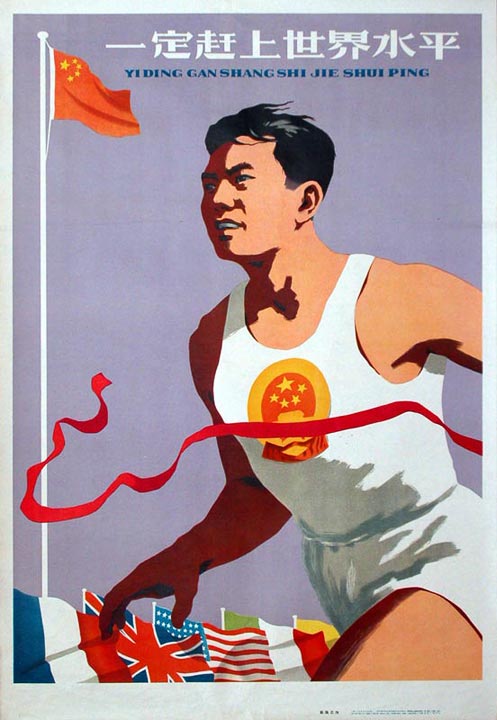
1958 – We'll definitely beat the world record
When France lost the Franco-Prussian war of 1870-71 (resulting in Germany being united into one country), French historian Pierre de Coubertin suggested that part of the reason for the defeat was a lack of physical education in the French soldiers.
In an industrializing country such as France, one could imagine that moving large groups of people away from pre-industrial, physically intensive agriculture and into the factory halls of the overcrowded and polluted cities could have some negative influences on the average worker's physical shape.
Whether or not there was an actual connection, the result of Coubertin's thinking was the modern Olympic games, a way to encourage improved physical education. The first poster shows that connection clearly enough. Maintaining a high level of physical fitness was essential, both with regards to potential recruits and reserve manpower.
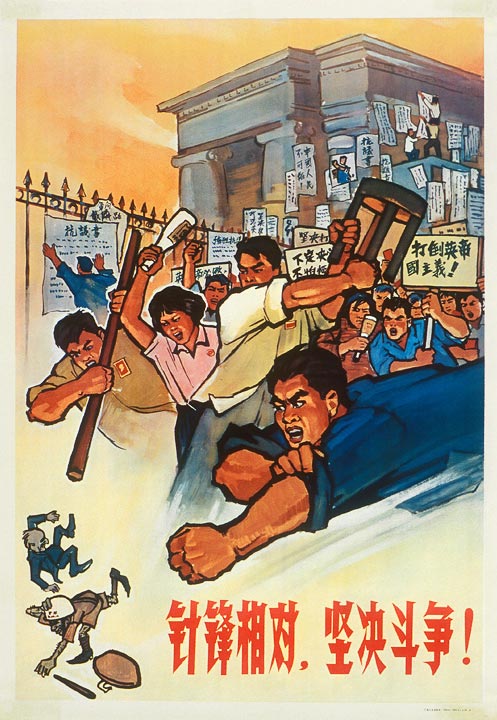
Mid-1960s – We want an eye for an eye and will fight resolutely
Up until 1997, two small pieces of China were still being held as colonies by European powers. Having suffered enormously at the hands of European colonial powers, the Chinese could hardly have been thrilled about these guests in their front yard. I'm talking about the small british colony of Hong Kong and the tiny Portugese Macau.
Hong Kong was handed over to the People's Republic in 1997, with Macau following in 1999, though both have been guaranteed the right to retain their political systems and internal affairs as they wish for 50 years. A suggestion for a similar system has been made towards the ROC for its future reintegration into the mainland state, and the Dalai Lama has proposed the same status for Tibet, though communist Chinese leaders have so far been negative in the latter case.
In the mid 60s Hong Kong's transition was far off, and as claimed by this poster, the Chinese were none too happy about it. Seen here is a violent demonstration favouring the return of Hong Kong to China, with two tiny caricatures of a british official and soldier/policeman being assaulted in the process.
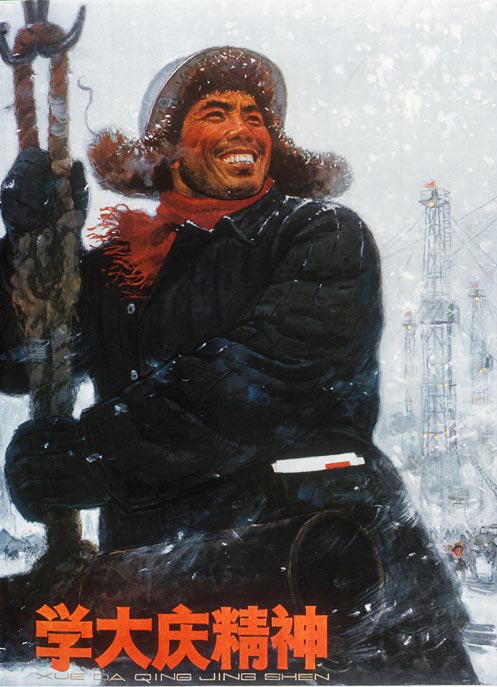
1965 – Learn from the spirit of Daqing
The fellow seen here is Wang Jinxi, nicknamed "Iron Man" for his willingness no keep on working through cruddy weather, injuries and fatigue. His best known workplace was the Daqing oil fields of China's north-eastern Heilongjiang province.
Development of the oil fields started in 1960 as part of a struggle to make the People's Republic self sufficient in oil, and as such, the development was a success, quickly becoming the country's most productive oil field.
This poster is a good example of an educational method Mao greatly believed in. By exposing average people to good models, in this case both the person Wang Jinxi and the Daqing oil fields with all its hard working people, they would adopt a part of the model into their own person and become a somewhat better person than before.
As such, bombarding people with good models should eventually result in a country full of hard working, incorruptible socialist heroes.
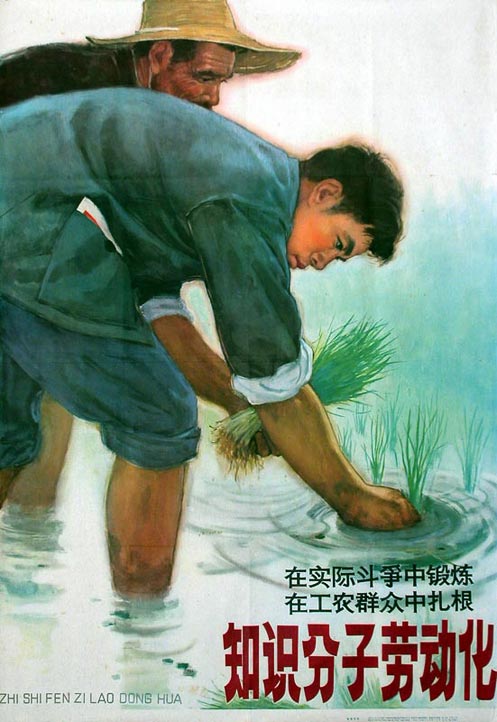
1965 – Ruralize the intellectuals
An awfully pretty poster, wouldn't you agree? Swaying fields of cereals are pretty too, but there is something particularly nice about rice fields, with calm water all around. To my knowledge the idea of forcing intellectuals and urbanites to work in the fields for a while to get in touch with the "common people" originated with Mao, but was taken to extremes by the Mao-inspired Khmer Rogue of Cambodia.
A period of learning in the countryside wasn't enough for the Khmer Rogue. Instead, urban residents were driven by force into the countryside permanently, leaving the cities deserted. In retrospect, that was just a mild foretaste to the horrors that would follow.
Friends abroad
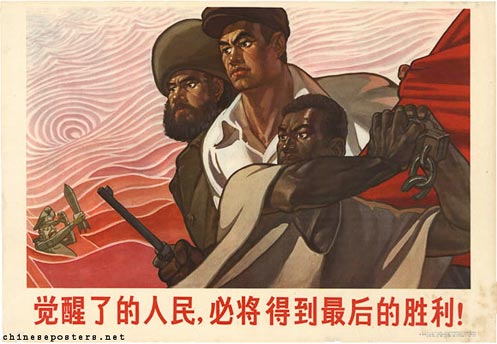
1963 – Awakened peoples, you will certainly attain the ultimate victory

Ca. 1964 – Resolutely support the anti-imperialist struggle of peoples in Asia, Africa and Latin-America
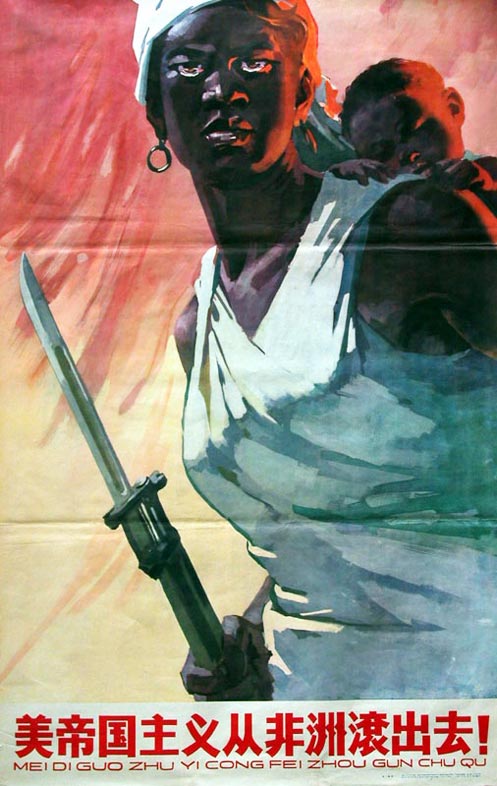
1964 – Get out of Africa, American imperialists

1964 – Oppressed peoples, unite to resolutely fight against US imperialism

1966 – Resolutely support the American people in their resistance against American imperialist aggression in Vietnam
Once the cold war had "settled down" in Europe, both sides increasingly turned their attention towards the third world, the developing countries of Asia, Africa and Latin-America. The US planned on containing communist influence within its current borders in Eastern Europe and Asia. Warfare in Korea and Vietnam was part of this basic idea.
Beyond this perimeter of containment lay the third world, ripe with opportunities for inciting insurrections against the western powers, and the Soviet Union quite easily jumped the fence and started supporting various regimes and rebellions throughout. Examples include Cuba, Vietnam, Egypt, Ethiopia, Angola and many more. These were civil wars as well as warfare against colonial powers, or perceived imperialists.
The US weren't particularly inclined to seing these countries going communist, and thus started supporting regimes, insurgencies and coups directed against communist threats, perceived or real.
With the split between the Soviet Union and the People's Republic, both were eager to be leaders of the communist world revolution, leading in many cases to both sponsoring different sides in conflicts of a single country. One example is Angola, where the Soviet Union supported the MPLA, while the UNITA and FNLA both at different times received aid from the People's Republic and the US.
Communist China weren't really successful in their third world sponsorships, though this is changing as we speak, with the People's Republic now making massive inroads in Africa, though nowadays more geared towards trade than ideology and regime change.
Despite their comparative lack of success in the third world during the cold war, the People's Republic managed to turn out some outstanding artwork for internal consumption showing suport for the various struggling peoples of the third world.
My favourites are the two 1964 posters. The first of the two features an utterly beautiful, fierce looking mother carrying an SKS rifle in her hand and her baby on her back. It's a terribly grim situation, but the artwork is gripping. The next poster, a black-white-and-red block print, conveys a terrifying sense of action and rebellion. The colour red is particularly useful in this sense, no other colour is as tightly connected with strife and rebellion.
Mao strikes back
Mao never liked being pushed aside. Some have suggested that his launch of the Great Leap Forward was not first and foremost to industrialize the People's Republic and make it self-sufficient, but rather a way for Mao to get himself back into the centre of action at a time when he felt he risked being sidelined.
Unfortunately for Mao (and the 30-40 million who died), the Great Leap was a Great Disaster and he was forced to retire into the background while more pragmatic people like Liu Shaoqi and Deng Xiaoping took the helm.

1966 – Chairman Mao is our heart's red sun
Mao however, would not be so easily outdone. Pictured here with a pinkish halo is a book called "Quotations from Chairman Mao Zedong", better known as Mao's Little Red Book. First published in 1961 for use by the soldiers and officers of the People's Liberation Army, it became a central element in the personality cult which was built up around Mao in the coming years.
Rivaling only the Bible, it's may be the single most printed book in history, with estimates ranging from 800 million to 6.5 billion copies made, or roughly enough for most present day human to have one each.
1966 was the year in which Mao launched the cultural revolution to once again put himself back in the centre. In essence, the cultural revolution consisted of closing the upper level educational system and encouraging its students to go search the country for class enemies of all sorts, people with ideas perceived as counter-revolutionary, as well as artefacts or structures considered old-fashioned (and thus bad).
The people who answered Mao's call to go out searching for counter-revolutionaries and "old culture" came to be known as Red Guards. Marking the start of the revolution, an estimated 11 million Red Guards descended upon Beijing where they had been assured room, board and acces to parks and museums.
They went to get a glimpse of the great Chairman himself, and he held a series of "audiences" so everyone would be able to get a look. Most traveled by train or other mechanized means, but there were also some who walked to get there. Echoing Mao's own great march of the mid 1930s, Red Guards who performed this march to Beijing were presumably due for some serious Red Cred. That Mao didn't actually do a lot of walking during the great march, but was carried most of the way is something he probably preferred to play down.
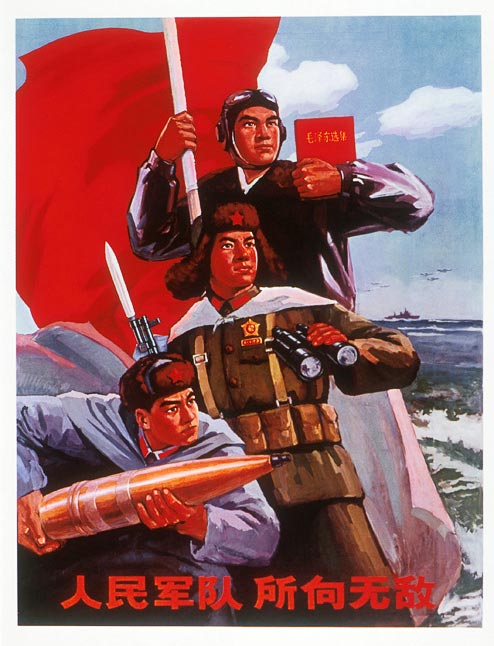
Late 1960s - A People's Army Has No Rival
As I've mentioned, the People's Liberation Army was, and is still a remarkably self-sufficient institution in China. Included in this was a great output of propaganda, though not all of it made for the benefit of the armed forces themselves. In particular, their printers were active in the production of posters promoting the personality cult around Mao, and it was the PLA which first published the Little Red Book in 1961.
During the Cultural Revolution, the army was ordered to assist the Red Guards and gradually got deeply involved in the revolution. The Red Guards eventually split into different factions, accusing each other of counter-revolutionary work, and fighting each other. They seized weapons from PLA armories, with the army ordered to remain neutral at first. As we will see, it eventually fell to the PLA to restore order once even Mao realized things had gotten out of hand.
The guy holding the grenade in this poster reminds me of western World War II propaganda, particularly out of the US, where there were numerous posters made featuring big burly men handling phallic ordnance with an intensely determined expression. I'm not usually one to agree with how feminists analyse present day human society and conclude that everything men creates in some way visually echoes a penis (yes, I am exaggerating), but in the case of these posters, there may be some amusing truth to it.
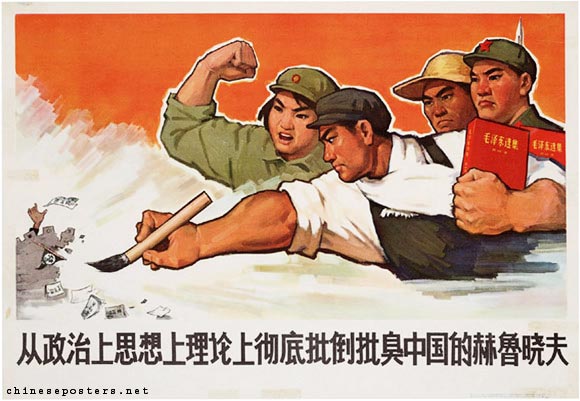
1967 – Fully criticize the Chinese Khrushchev from a political, ideological and theoretical perspective

1967 – Completely smash the Liu-Deng counter-revolutionary line
The red book seen in the arms of the muscle men on both these posters is the Little Red Book. Get used to it, you'll be seeing a lot of it from here on.
The victims are Liu Shaoqi and Deng Xiaoping. Prior to the cultural revolution, Liu was expected to become Mao's successor, but having criticized Mao and upstaged him after the Great Leap, he became the favourite scapegoat and archetype of a counter-revolutionary during the Cultural Revolution.
As seen in the second poster, he came to be known as the Chinese Kruhshchev, not a positive label considering the icy relations between the Soviet Union and the People's Republic at the time. He died under harsh treatment in captivity in 1968. Deng Xiaoping was luckier, he was stripped of his offices, subjected to "re-education" and sent to work at an engine factory.
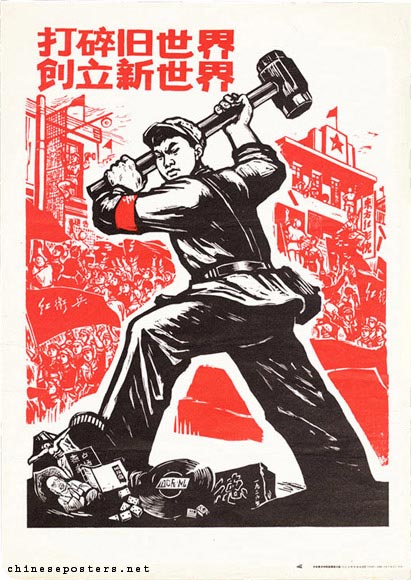
1967 – Scatter the old world, build a new world
The Red Guards travelled the country by the millions, smashing ancient artefacts and buildings while accusing all kinds of people of being counter-revolutionary, including each other.
Often, their actions would not be limited to vocal or printed accusations, but extended into physical attacks, with rape, torture and murder being commonplace. Furthermore, thousands were driven to suicide.
The death toll has been estimated between 500 000 and 3 million. Added to that, a vast amount of the cultural heritage of China and its occupied areas vanished through the destruction of artefacts and structures considered old-fashioned. In Tibet alone, an impressive 6000 monasteries were laid to waste. Simply put, they went berserk in the China store, like a horde of rabid pandas.
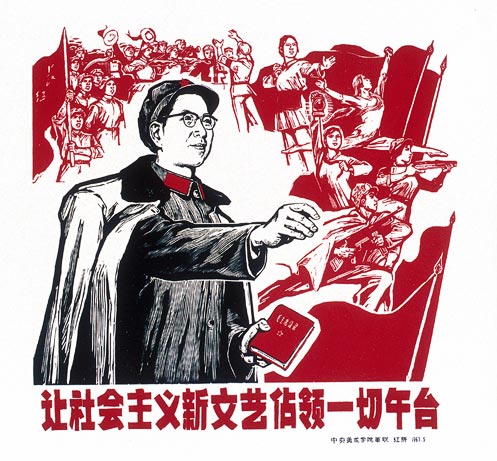
1967 – Let new socialist culture occupy every stage
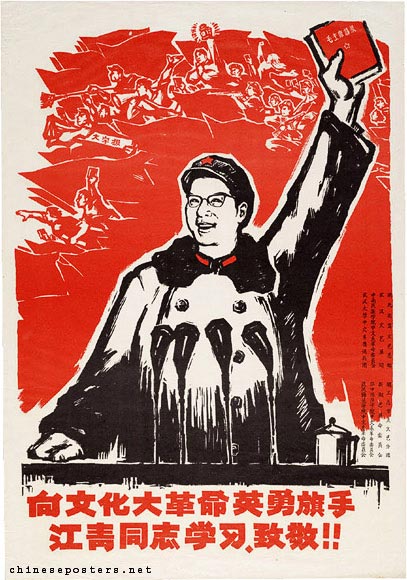
1967 – Learn from the valiant standard-bearer of the Great Cultural Revolution, comrade Jiang Qing, and pay her respect!
Say hello to Madame Mao. She was the third and last wife of Mao, and came into prominence during the cultural revolution. Originally an actress, directing a cultural revolution apparently came naturally to her. She was not terribly popular at the time, so posters featuring her were comparatively rare.
Disregarding all the rubbish that came with the cultural revolution, the artists behind the propaganda posters of that period deserve praise. There is an unusual uniformity in the style and simplicity of a large amount of propaganda from this time.
From what I've been able to gather, the reason for this is that more posters than usual were produced at a local level, rather than at the big, more advanced printing workshops. The lack of advanced printing equipment meant that artists where required to design posters which could be printed with the simpler equipment available.
The result was a bold and striking style using only black, white and red. Far from harmonious, this style seems perfect for the turmoil of a revolution, whatever its nature. This was not the time to brag about the plumpness of the harvest or the importance of steel production, it was a time for running amok, and in that context, this style was just what the doctor ordered.
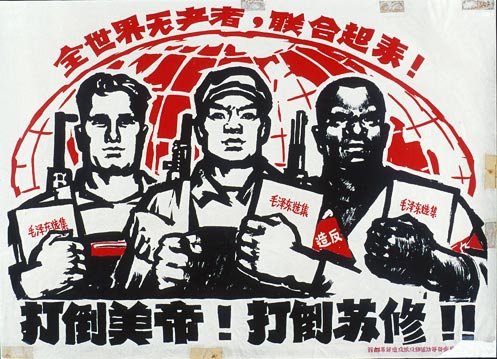
1967 – Down with American Imperialists and Russian Revisionists!

1968 – Chairman Mao is the great liberator of the world's revolutionary people
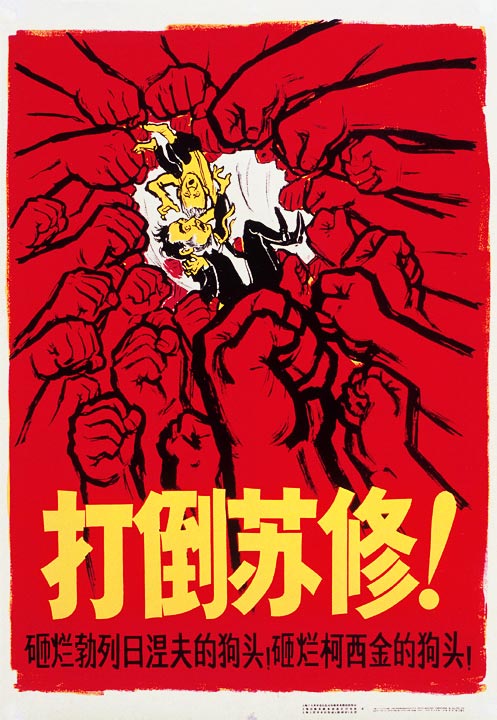
1967 – Smash the Soviet Revisionists!
Even in the midst of the cultural revolution, there was time to worry about the world beyond the borders of the People's Republic. As the first and second poster shows, Mao's Little Red Book had by now been distributed to rebellious friends all around the world.
The Little Red came to be seen as a sort of miracle cure for everything. According to legend, people along the coast of China once joined together and used it to stop a tidal wave. Armed with such powerful magic, one could hardly expect anything but the swift and total fall of world capitalism at the hands of these rebels.
The third poster illustrates the seriousness of the Sino-Soviet split which had been developing since the late 1950s. Pictured is the Soviet chairman Leonid Brezhnev and his premier, Alexey Kosygin.
These two had been visited by Chinese prime minister Zhou Enlai in 1964 after Khrushchev had been ousted, and there was a pause in the war of words between the two. But when Zhou returned, he reported that Brezhnev did not plan on changing the Soviet's attitude towards the People's republic, and as this poster shows, the split remained, and worsened as the cultural revolution went ahead. In 1969, it turned into open confrontation between the two, and there was great fear of war between the two communist states.

1968 – Chairman Mao goes to Anyuan
Just like the little Red Book was extensively reproduced, so too was this particular painting. It shows a young Mao striding towards Anyuan in somewhat ominous weather. His clenched fist, his simple dress, his determined face are all intentionally included to strengthen the image of the great leader. With the chosen perspective, he rises miles above the mountains, the master of all he surveys.
A part of the "hidden" message of this painting was directed at one of Mao's chosen enemies of the cultural revolution, Liu Shaoqi who had a better historical claim to Anyuan, having arranged a string of railway strikes there in the 1920s. In that perspective, this was just one more step in stripping Liu of any credentials he might have.
Supposedly, nearly a billion copies of this painting were printed, and in addition, as we'll see later, it also came to be incorporated into later posters, as a sort of holy object which people would carry around, just like the Little Red Book.
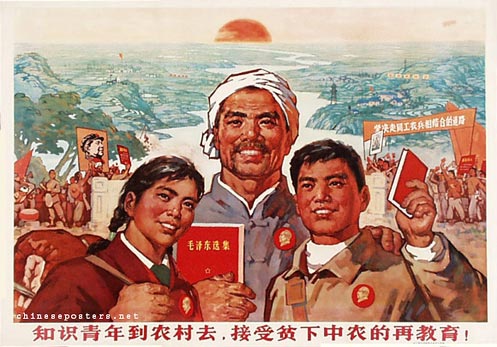
1969 – Educated youth must go to the countryside
When the Red Guards started seizing weaponry from the People's Liberation Army and fighting each other, Mao got fed up with the experience and decided to call it off. As this poster shows, the guards where ordered to disperse into the countryside for some healthy ruralizing. Some refused, whereupon Mao sent in the army. Thus the most dramatic part of the Cultural Revolution came to an end, though it would continue in new forms for another seven years.
Acknowledgements: This series would never have been possible without the two websites listed beneath. These are the kinds of sites that really make me love the Internet. If you enjoy what you've seen in these posts, spending a few hours (or days) exploring these websites is not a bad way of spending your time
Chineseposters.net - Hosted and designed by the International Institute of Social History in Amsterdam, this website presents the poster collections of the IISH and that of Stefan R. Landsberger. Landsberger is the editor of this utterly fascinating site, which he runs together with co-editor Marien van der Heijden.
It includes a vast collection of imagery, accompanied by a wealth of well written commentary and discussion, putting the imagery in the right context, and I've drawn much on it in the writing of these posts.
Maopost.com - Another huge collection of propaganda. Not as much commentary as in the former, but including an online collection of over 1600 posters in good quality. For those who get hooked on this stuff and have a few hundred dollars to spend, Maopost offers hand painted copies of a selection of posters where you can get a face of your choice (including your own) painted into an otherwise authentic poster.
